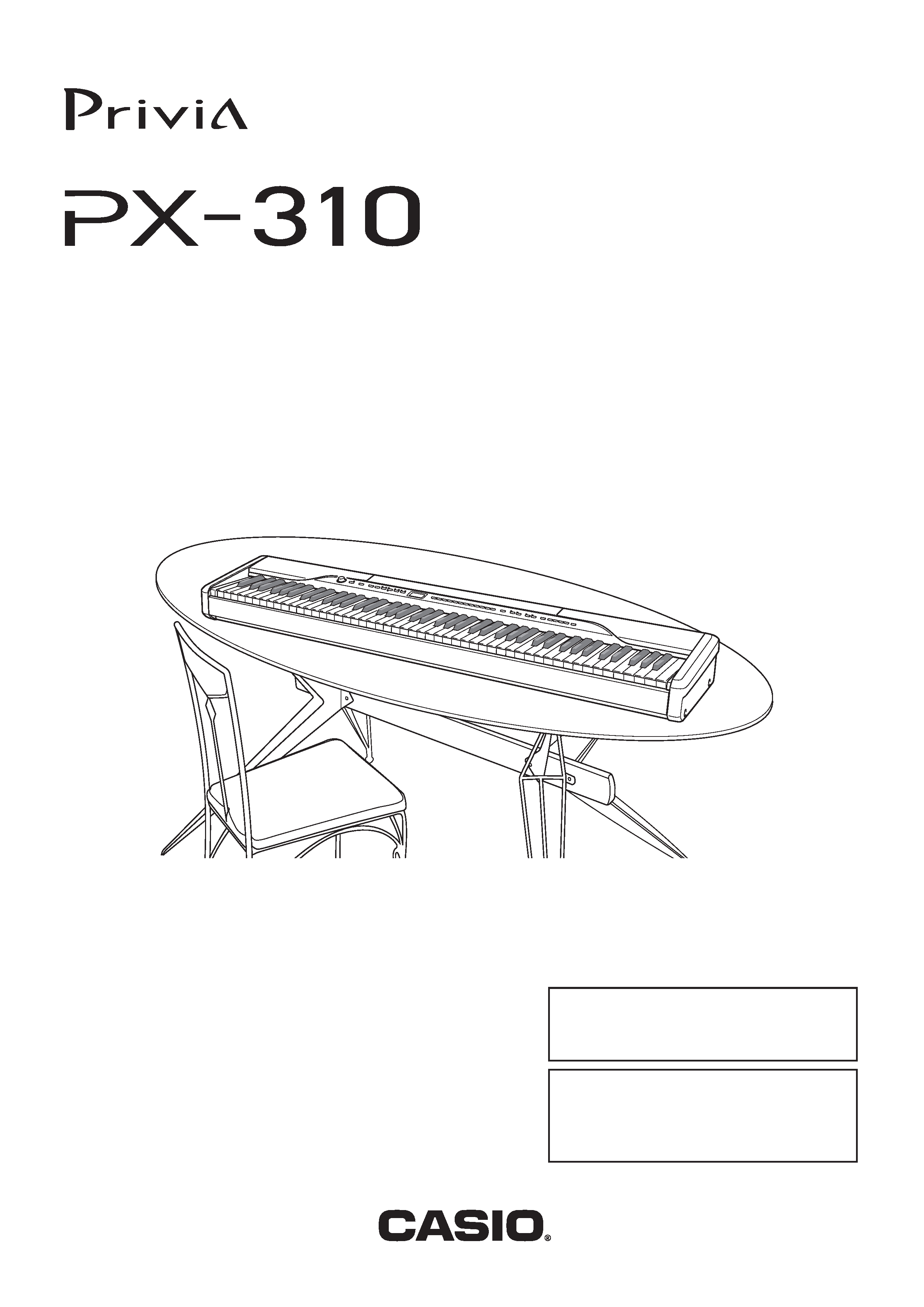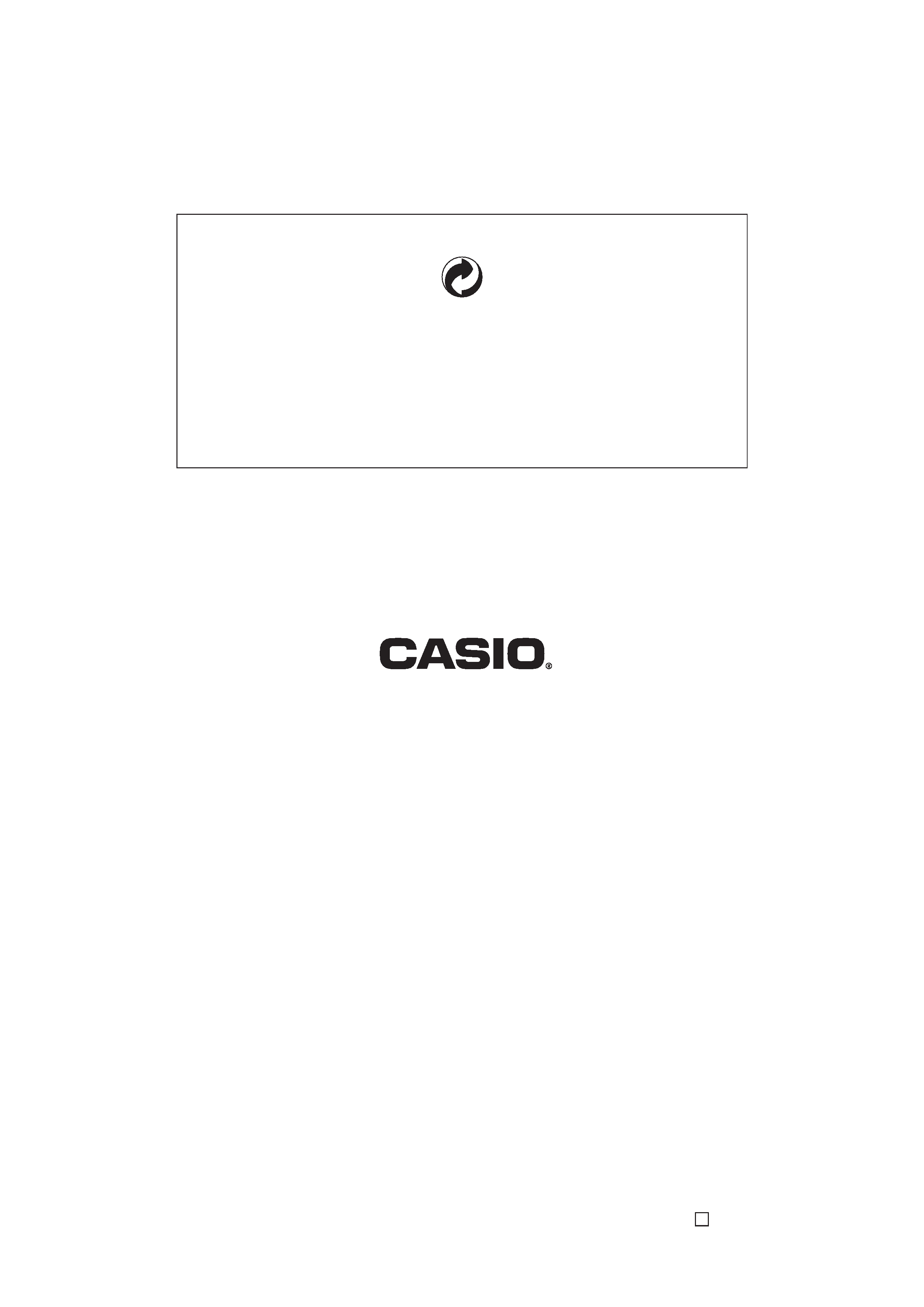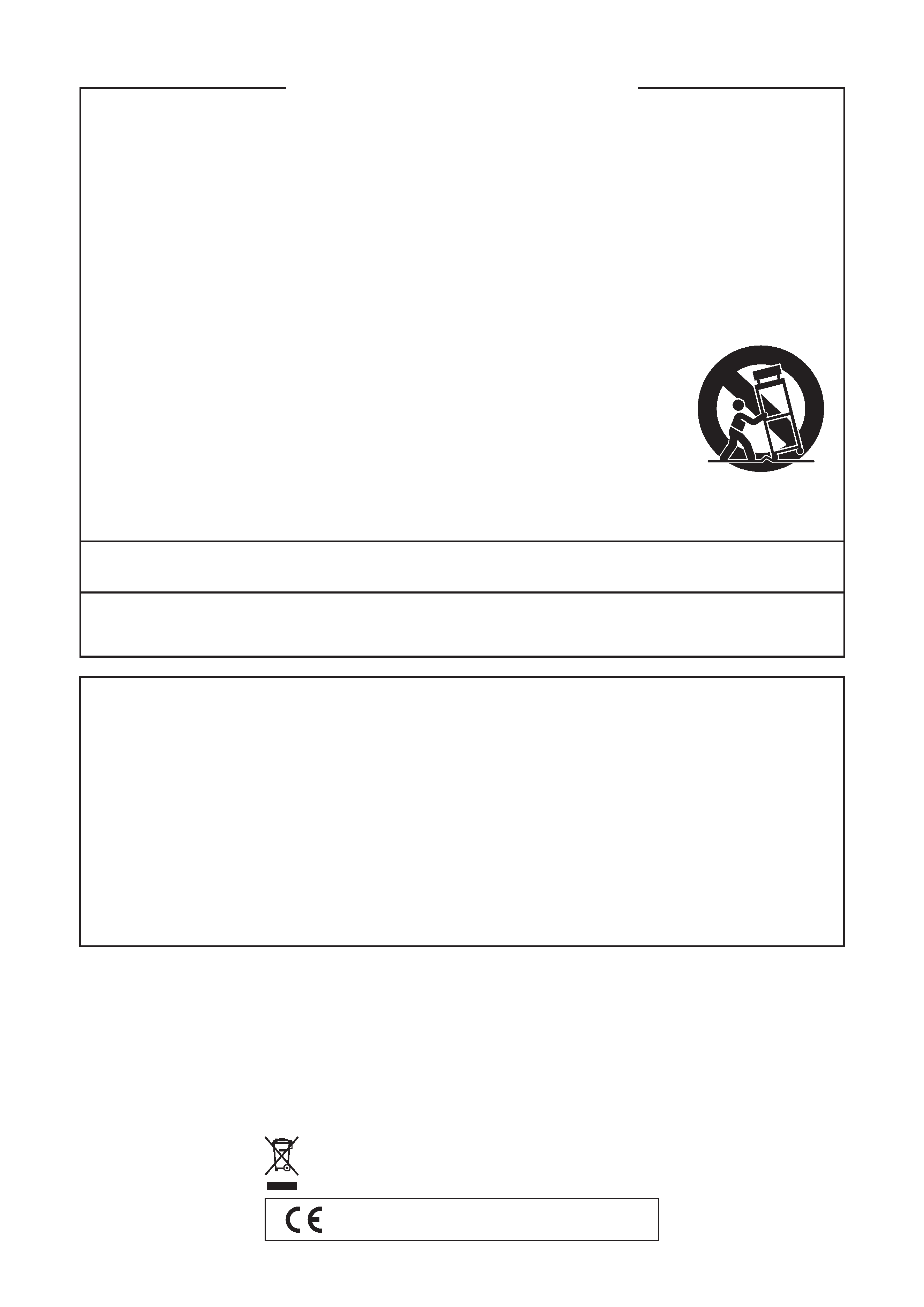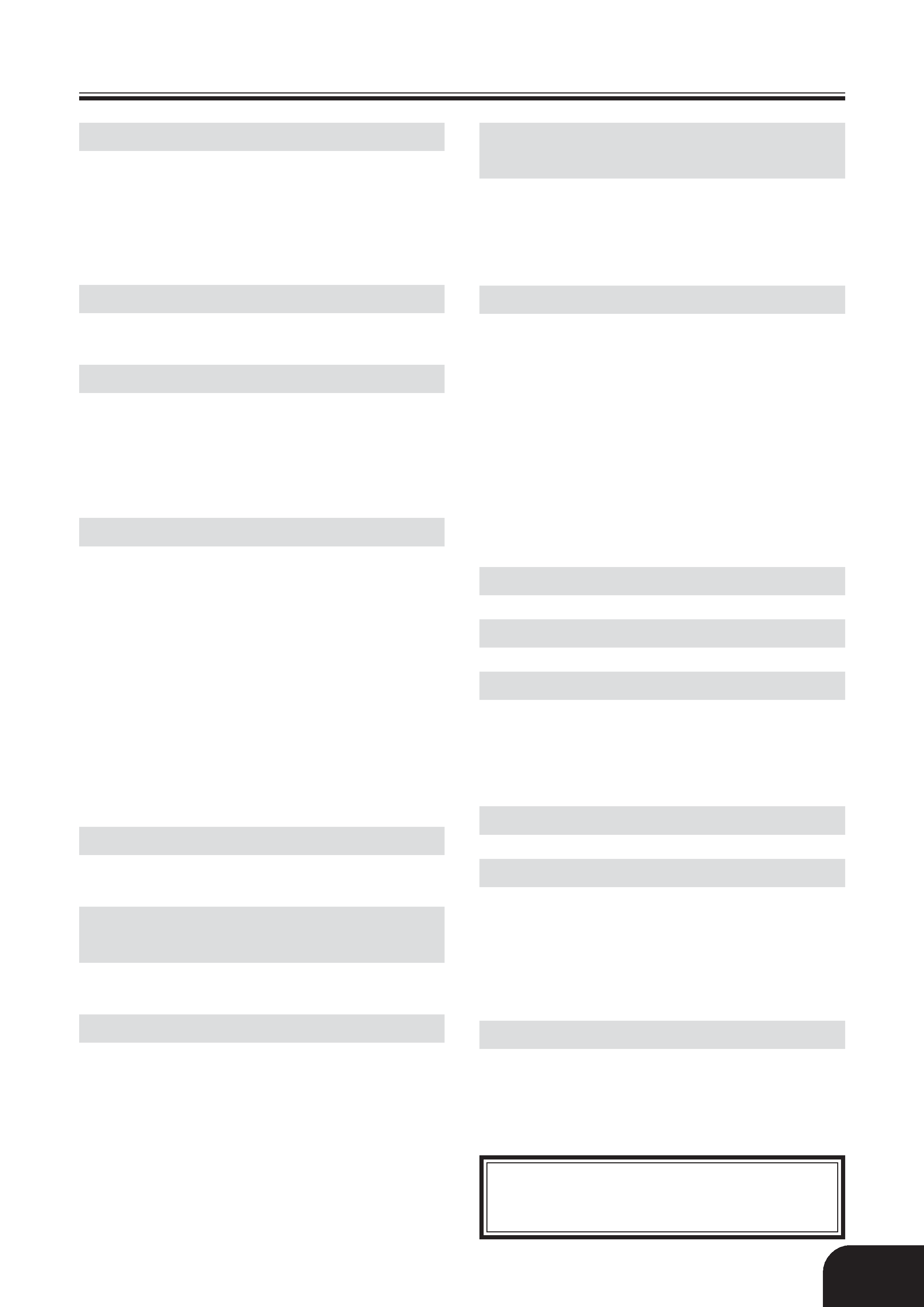
PX310ES1B
ES
USER'S GUIDE
GUÍA DEL USUARIO
Please keep all information for future reference.
Guarde toda información para tener como referencia futura.
Safety Precautions
Before trying to use the piano, be sure to
read the separate "Safety Precautions".
Precauciones de seguridad
Antes de intentar usar el piano, asegúrese
de leer las "Precauciones de seguridad"
separadas.

This recycle mark indicates that the packaging conforms to
the environmental protection legislation in Germany.
Esta marca de reciclaje indica que el empaquetado se
ajusta a la legislación de protección ambiental en Alemania.
MA0508-B Printed in China
PX310ES1B
P
CASIO COMPUTER CO.,LTD.
6-2, Hon-machi 1-chome
Shibuya-ku, Tokyo 151-8543, Japan

407A-E-002A
CASIO Europe GmbH
Bornbarch 10, 22848 Norderstedt, Germany
Important!
Please note the following important information before using this product.
· Before using the AD-12 Adaptor to power the unit, be sure to check the AC Adaptor for any damage first. Carefully
check the power cord for breakage, cuts, exposed wire and other serious damage. Never let children use an AC adaptor
that is seriously damaged.
· The product is not intended for children under 3 years.
· Use only CASIO AD-12 adaptor.
· The AC adaptor is not a toy.
· Be sure to disconnect the AC adaptor before cleaning the product.
IMPORTANT SAFETY INSTRUCTIONS
1. Read these instructions.
2. Keep these instructions.
3. Heed all warnings.
4. Follow all instructions.
5. Do not use this apparatus near water.
6. Clean only with dry cloth.
7. Do not block any ventilation openings. Install in accordance with the manufacturer's instructions.
8. Do not install near any heat sources such as radiators, heat registers, stoves, or other apparatus (including
amplifiers) that produce heat.
9. Do not defeat the safety purpose of the polarized or grounding-type plug. A polarized plug has two blades with
one wider than the other. A grounding type plug has two blades and a third grounding prong. The wide blade or
the third prong are provided for your safety. If the provided plug does not fit into your outlet, consult an electrician
for replacement of the obsolete outlet.
10. Protect the power cord from being walked on or pinched particularly at plugs, convenience receptacles, and the
point where they exit from the apparatus.
11. Only use attachments/accessories specified by the manufacturer.
12. Use only with the cart, stand, tripod, bracket, or table specified by the manufacturer, or
sold with the apparatus. When a cart is used, use caution when moving the cart/apparatus
combination to avoid injury from tip-over.
13. Unplug this apparatus during lightning storms or when unused for long periods of time.
14. Refer all servicing to qualified service personnel. Servicing is required when the apparatus has been damaged in
any way, such as power-supply cord or plug is damaged, liquid has been spilled or objects have fallen into the
apparatus, the apparatus has been exposed to rain or moisture, does not operate normally, or has been dropped.
The apparatus shall not be exposed to dripping or splashing and that no objects filled with liquids, such as vases,
shall be placed on the apparatus.
The power indicator being unlit does not mean the apparatus is completely disconnected from the MAINS.
When you need to have the apparatus completely disconnected from the MAINS, you must unplug the power cord.
For that purpose, locate the apparatus in a way that secures easy access to the power cord.
TO REDUCE THE RISK OF FIRE OR ELECTRIC SHOCK, REFER SERVICING TO QUALIFIED SERVICE PERSONNEL.
This mark applies in EU countries only.
NOTICE
This equipment has been tested and found to comply with the limits for a Class B digital device, pursuant to Part 15 of
the FCC Rules. These limits are designed to provide reasonable protection against harmful interference in a residential
installation. This equipment generates, uses and can radiate radio frequency energy and, if not installed and used in
accordance with the instructions, may cause harmful interference to radio communications. However, there is no guarantee
that interference will not occur in a particular installation. If this equipment does cause harmful interference to radio or
television reception, which can be determined by turning the equipment off and on, the user is encouraged to try to
correct the interference by one or more of the following measures:
· Reorient or relocate the receiving antenna.
· Increase the separation between the equipment and receiver.
· Connect the equipment into an outlet on a circuit different from that to which the receiver is connected.
· Consult the dealer or an experienced radio/TV technician for help.
FCC WARNING
Changes or modifications not expressly approved by the party responsible for compliance could void the user's author-
ity to operate the equipment.

E-1
Contents
Company and product names used in this
manual may be registered trademarks of others.
407A-E-003A
General Guide .......................... E-2
Attachment of the Score Stand .................. E-2
About the FUNCTION button ...................... E-3
Numeric Input Keys and +/ Keys .............. E-4
Playing Back All the demo Tunes ............... E-4
Power Supply ........................... E-4
Using the AC Adaptor ................................. E-4
Connections ............................. E-5
Connecting Headphones ............................ E-5
Connecting an audio or musical
instrument amplifier .................................... E-5
Connecting to a PEDAL Jack ..................... E-6
Playing with Different Tones ..... E-7
Selecting and Playing a Tone ..................... E-7
Selecting Main Tones and Variation Tones ... E-7
Selecting an Advanced Tone, GM Tone,
or Drum Set ................................................ E-7
Adjusting the Brilliance of a Tone ............... E-8
Layering Two Tones .................................... E-8
Assigning Different Tones to the Left and
Right Sides of the Keyboard ....................... E-9
Using Tone Effects .................................... E-10
Using the Piano's Pedals .......................... E-11
Playing Rhythms .................... E-12
Using Auto Accompaniment ...................... E-13
Playing Tunes You
Download from the Internet .... E-16
Practicing a Tune ...................................... E-17
Using Registration Memory .... E-18
What is registration memory? ................... E-18
Recording to and Playing Back
from Song Memory ................. E-20
Recording Your Keyboard Play ................. E-21
Playing Back from Song Memory ............. E-22
Deleting Song Memory Data .................... E-23
Other Settings ........................ E-24
Adjusting Accompaniment Volume ........... E-24
Changing the Keyboard Touch ................. E-24
Changing the Piano Key ........................... E-25
Changing the Pitch of the Piano to
Match Another Instrument ........................ E-25
Using Digital Piano Setup Memory ........... E-25
Using MIDI ................................................ E-25
Saving the Song Data You Download
from the Internet ....................................... E-26
Troubleshooting ..................... E-28
Specifications......................... E-29
Operational Precautions ....... E-30
Locating the Unit ....................................... E-30
Care of the Unit ......................................... E-30
Lithium Battery .......................................... E-30
Setting Control Key Chart ..... E-31
Appendix ..................................A-1
Tone List ..................................................... A-1
Rhythm List ................................................. A-2
Drum Assignment List ................................. A-3
Fingered Chord Chart ................................. A-4
MIDI Implementation Chart

E-2
General Guide
Bottom
Attachment of the Score Stand
Insert the score stand into the slot at the top of the
digital piano as shown in the illustration.
Left Side Panel
407A-E-004A
67
8
9
1
E
F
G H I J K L
M
T
V
W
Q R S
U
N
O
P
0
A
B
D
C
2
3
4
5
NOTE
· Each chapter of this manual starts with an illustration
of the piano's console, which shows the buttons and
other controllers you need to operate.
FUNCTION
VOLUME
Back Panel
